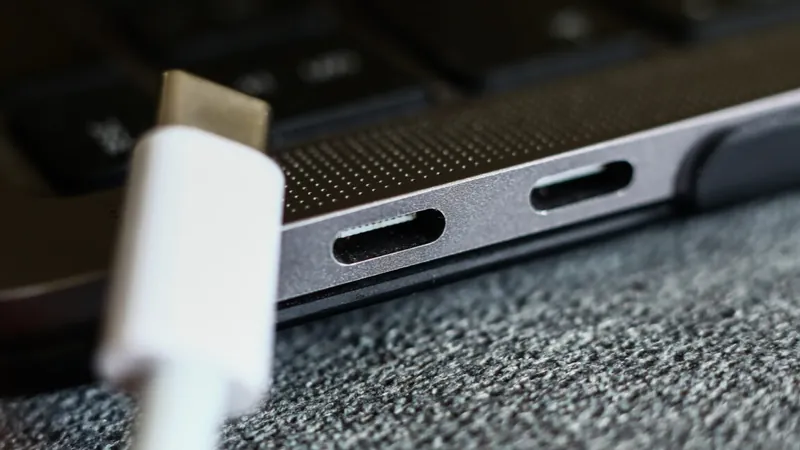
USB-C Revolutionizes Charging: EU's Groundbreaking Directive Takes Effect
2025-01-02
Author: Wei
Introduction
On December 28, 2024, the European Commission shared the message, "It's time for THE charger," a sentiment marking a pivotal moment for consumers across the European Union. The newly enacted Common Charger Directive aims to streamline the charging experience by mandating a universal solution for a wide range of electronic devices. This initiative is particularly relevant in an age dominated by an overwhelming number of charging cables and adapters.
Overview of the Common Charger Directive
The essence of the Common Charger Directive is straightforward: all "radio equipment" equipped with either removable or embedded rechargeable batteries must feature a USB-C receptacle if it allows wired recharging. This means any device that can be powered via USB-C and consumes up to 100 watts falls under the directive's requirements. Notably, this regulation applies to products that enter the market after the mandate came into effect, even if their design and initial production predate this regulation.
Laptops have an extended grace period until April 2026 to achieve compliance, whereas other electronics—including smartphones, tablets, handheld gaming devices, computer accessories, and wireless headphones—are now required to utilize USB-C for sale within the EU. Drones are notably absent from these initial regulations, but the EU is expected to address this in the near future.
Exceptions and Specifications: What You Need to Know
While the directive significantly narrows down the types of connectors used by electronics, there are exceptions. Devices with non-rechargeable batteries, such as traditional AA or AAA batteries, are exempt, meaning certain smart home devices may still use their original charging formats. Additionally, while the law encompasses most rechargeable devices, it allows for vague exceptions regarding gadgets that charge within a protective case, although earbud cases must comply. Devices emphasizing wireless charging are also not required to adapt to USB-C; however, they can include USB-C as an additional option alongside proprietary charging methods like Apple's MagSafe.
Impact on Technology: A Major Shift for Apple
The introduction of this directive is already reshaping the tech landscape, particularly for industry giants like Apple. Initially resistant to any changes, Apple has commenced the transition from its proprietary Lightning connector to USB-C across its product range. Recently, the company has halted the sales of Lightning-charging variants of the iPhone 14 and iPhone SE within the EU, moving exclusively towards USB-C.
One of the most notable aspects of the directive is its stipulation regarding "fast charging.” Devices that exceed 5 volts, 3 amperes, or 15 watts must adhere to the USB Power Delivery (USB PD) standard, ensuring they communicate charging rates efficiently with any compatible charger, thus reducing reliance on proprietary charging bricks.
Communicating Standards to Consumers
Under the new regulations, manufacturers must clearly indicate on packaging whether a product includes a charging plug or mid-cord brick. Labels will also detail the minimum and maximum power requirements for charging, as well as if the device supports USB PD. This clarity aims to empower consumers, allowing them to make informed decisions while purchasing tech products.
The Road Ahead: Industry Criticism and Consumer Benefits
Though celebrated by many, the move towards a single charging standard has faced skepticism from critics who argue it might hinder the industry's innovation in charging technology. However, the directive includes provisions to address concerns, offering exemptions for more powerful devices and enabling alternative power solutions where necessary, while still aiming to tackle the issues of e-waste and consumer confusion.
The effectiveness of the Common Charger Directive hinges on how it will be enforced, as the responsibility lies with individual EU member countries. Additionally, it remains to be seen if companies will adopt these compliance standards uniformly or create separate lines of products specifically tailored for the EU market.
As the dust settles on this transformative change, one thing is clear: the EU has initiated a significant step towards unifying and simplifying charging technology, a move that reflects a growing global emphasis on sustainability and consumer convenience. Will we soon see a world where tangled cords and multiple adapters become relics of the past? Only time will tell!
 Brasil (PT)
Brasil (PT)
 Canada (EN)
Canada (EN)
 Chile (ES)
Chile (ES)
 Česko (CS)
Česko (CS)
 대한민국 (KO)
대한민국 (KO)
 España (ES)
España (ES)
 France (FR)
France (FR)
 Hong Kong (EN)
Hong Kong (EN)
 Italia (IT)
Italia (IT)
 日本 (JA)
日本 (JA)
 Magyarország (HU)
Magyarország (HU)
 Norge (NO)
Norge (NO)
 Polska (PL)
Polska (PL)
 Schweiz (DE)
Schweiz (DE)
 Singapore (EN)
Singapore (EN)
 Sverige (SV)
Sverige (SV)
 Suomi (FI)
Suomi (FI)
 Türkiye (TR)
Türkiye (TR)
 الإمارات العربية المتحدة (AR)
الإمارات العربية المتحدة (AR)